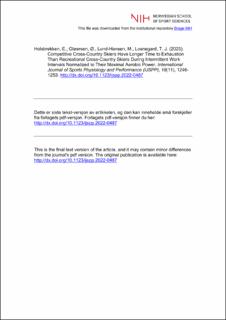| dc.contributor.author | Holsbrekken, Eivind | |
| dc.contributor.author | Gløersen, Øyvind | |
| dc.contributor.author | Lund-Hansen, Magne | |
| dc.contributor.author | Losnegard, Thomas Johansen | |
| dc.date.accessioned | 2024-01-12T11:51:50Z | |
| dc.date.available | 2024-01-12T11:51:50Z | |
| dc.date.created | 2023-11-17T10:57:49Z | |
| dc.date.issued | 2023 | |
| dc.identifier.citation | International Journal of Sports Physiology and Performance (IJSPP). 2023, 18(11), 1246-1253. | en_US |
| dc.identifier.issn | 1555-0265 | |
| dc.identifier.uri | https://hdl.handle.net/11250/3111290 | |
| dc.description | I Brage finner du siste tekst-versjon av artikkelen, og den kan inneholde ubetydelige forskjeller fra forlagets pdf-versjon. Forlagets pdf-versjon finner du på humankinetics.com / In Brage you'll find the final text version of the article, and it may contain insignificant differences from the journal's pdf version. The definitive version is available at humankinetics.com | en_US |
| dc.description.abstract | Purpose: To investigate differences in time to exhaustion (TTE), O2 uptake (˙VO2), and accumulated O2 deficit (Odef2) between competitive and recreational cross-country (XC) skiers during an intermittent-interval protocol standardized for maximal aerobic power (MAP). Methods: Twelve competitive (maximal ˙VO2 [˙VO2max]=76.5±3.8mL⋅kg−1⋅min−1) and 10 recreational (˙VO2max=63.5±6.3mL⋅kg−1⋅min−1) male XC skiers participated. All tests were performed on a rollerski treadmill in the V2 ski-skating technique. To quantify MAP and maximal accumulated oxygen deficit (MAOD), the skiers performed a steady-state submaximal test followed by a 1000-m time trial. After a 60-minute break, TTE, ˙VO2, and accumulated Odef2 were measured during an intermittent-interval protocol (40-s work and 20-s recovery), which was individually tailored to 120% and 60% of each subject’s MAP. Results: During the 1000-m time trial, the competitive skiers had 21% (95% CI, 12%–30%) shorter finish time and 24% (95% CI, 14%–34%) higher MAP (all P < .01) than the recreational skiers. No difference was observed in relative exercise intensity (average power/MAP; P = .28), MAOD (P = .18), or fractional utilization of ˙VO2max. During the intermittent-interval protocol, the competitive skiers had 34% (95% CI, 3%–65%) longer TTE (P = .03) and accumulated 61% (95% CI, 27%–95%) more Odef2 (P = .001) than the recreational skiers during work phases. Conclusions: Competitive XC skiers have longer TTE and accumulate more Odef2 than recreational XC skiers during an intermittent-interval protocol at similar intensity relative to MAP. This implies that performance in intermittent endurance sports is related to the ability to repeatedly recharge fractions of MAOD. | en_US |
| dc.language.iso | eng | en_US |
| dc.subject | endurance | en_US |
| dc.subject | supramaximal intensity | en_US |
| dc.subject | oxygen deficit | en_US |
| dc.subject | oxygen uptake | en_US |
| dc.title | Competitive Cross-Country Skiers Have Longer Time to Exhaustion Than Recreational Cross-Country Skiers During Intermittent Work Intervals Normalized to Their Maximal Aerobic Power | en_US |
| dc.type | Peer reviewed | en_US |
| dc.type | Journal article | en_US |
| dc.description.version | acceptedVersion | en_US |
| dc.source.pagenumber | 1246-1253 | en_US |
| dc.source.volume | 18 | en_US |
| dc.source.journal | International Journal of Sports Physiology and Performance (IJSPP) | en_US |
| dc.source.issue | 11 | en_US |
| dc.identifier.doi | 10.1123/ijspp.2022-0487 | |
| dc.identifier.cristin | 2197996 | |
| dc.description.localcode | Institutt for fysisk prestasjonsevne / Department of Physical Performance | en_US |
| cristin.ispublished | true | |
| cristin.fulltext | postprint | |
| cristin.qualitycode | 1 | |
